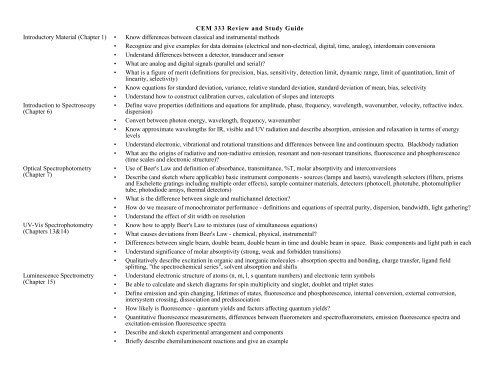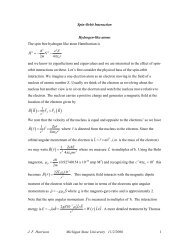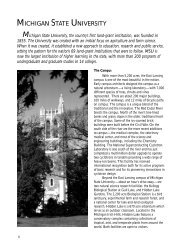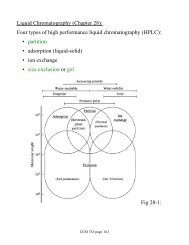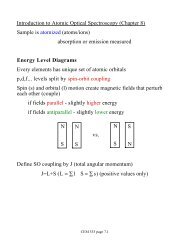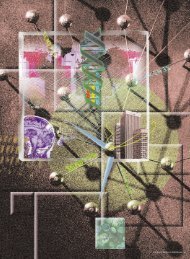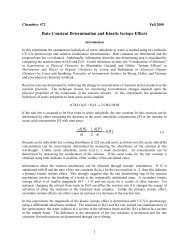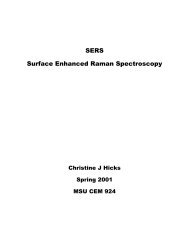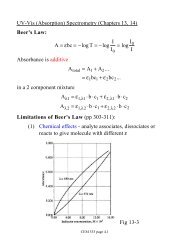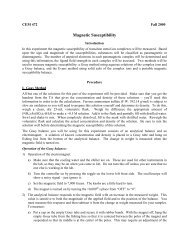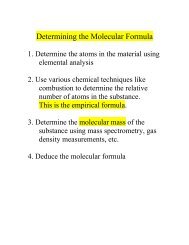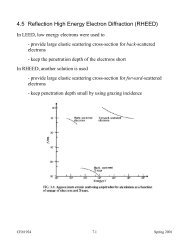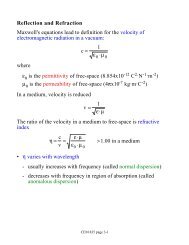CEM 333 Review and Study Guide Introductory Material (Chapter 1 ...
CEM 333 Review and Study Guide Introductory Material (Chapter 1 ...
CEM 333 Review and Study Guide Introductory Material (Chapter 1 ...
Create successful ePaper yourself
Turn your PDF publications into a flip-book with our unique Google optimized e-Paper software.
<strong>CEM</strong> <strong>333</strong> <strong>Review</strong> <strong>and</strong> <strong>Study</strong> <strong>Guide</strong><strong>Introductory</strong> <strong>Material</strong> (<strong>Chapter</strong> 1) • Know differences between classical <strong>and</strong> instrumental methods• Recognize <strong>and</strong> give examples for data domains (electrical <strong>and</strong> non-electrical, digital, time, analog), interdomain conversions• Underst<strong>and</strong> differences between a detector, transducer <strong>and</strong> sensor• What are analog <strong>and</strong> digital signals (parallel <strong>and</strong> serial)?• What is a figure of merit (definitions for precision, bias, sensitivity, detection limit, dynamic range, limit of quantitation, limit oflinearity, selectivity)• Know equations for st<strong>and</strong>ard deviation, variance, relative st<strong>and</strong>ard deviation, st<strong>and</strong>ard deviation of mean, bias, selectivity• Underst<strong>and</strong> how to construct calibration curves, calculation of slopes <strong>and</strong> interceptsIntroduction to Spectroscopy(<strong>Chapter</strong> 6)Optical Spectrophotometry(<strong>Chapter</strong> 7)UV-Vis Spectrophotometry(<strong>Chapter</strong>s 13&14)Luminescence Spectrometry(<strong>Chapter</strong> 15)• Define wave properties (definitions <strong>and</strong> equations for amplitude, phase, frequency, wavelength, wavenumber, velocity, refractive index.dispersion)• Convert between photon energy, wavelength, frequency, wavenumber• Know approximate wavelengths for IR, visible <strong>and</strong> UV radiation <strong>and</strong> describe absorption, emission <strong>and</strong> relaxation in terms of energylevels• Underst<strong>and</strong> electronic, vibrational <strong>and</strong> rotational transitions <strong>and</strong> differences between line <strong>and</strong> continuum spectra. Blackbody radiation• What are the origins of radiative <strong>and</strong> non-radiative emission, resonant <strong>and</strong> non-resonant transitions, fluorescence <strong>and</strong> phosphorescence(time scales <strong>and</strong> electronic structure)?• Use of Beer's Law <strong>and</strong> definition of absorbance, transmittance, %T, molar absorptivity <strong>and</strong> interconversions• Describe (<strong>and</strong> sketch where applicable) basic instrument components - sources (lamps <strong>and</strong> lasers), wavelength selectors (filters, prisms<strong>and</strong> Eschelette gratings including multiple order effects), sample container materials, detectors (photocell, phototube, photomultipliertube, photodiode arrays, thermal detectors)• What is the difference between single <strong>and</strong> multichannel detection?• How do we measure of monochromator performance - definitions <strong>and</strong> equations of spectral purity, dispersion, b<strong>and</strong>width, light gathering?• Underst<strong>and</strong> the effect of slit width on resolution• Know how to apply Beer's Law to mixtures (use of simultaneous equations)• What causes deviations from Beer's Law - chemical, physical, instrumental?• Differences between single beam, double beam, double beam in time <strong>and</strong> double beam in space. Basic components <strong>and</strong> light path in each• Underst<strong>and</strong> significance of molar absorptivity (strong, weak <strong>and</strong> forbidden transitions)• Qualitatively describe excitation in organic <strong>and</strong> inorganic molecules - absorption spectra <strong>and</strong> bonding, charge transfer, lig<strong>and</strong> fieldsplitting, "the spectrochemical series", solvent absorption <strong>and</strong> shifts• Underst<strong>and</strong> electronic structure of atoms (n, m, l, s quantum numbers) <strong>and</strong> electronic term symbols• Be able to calculate <strong>and</strong> sketch diagrams for spin multiplicity <strong>and</strong> singlet, doublet <strong>and</strong> triplet states• Define emission <strong>and</strong> spin changing, lifetimes of states, fluorescence <strong>and</strong> phosphorescence, internal conversion, external conversion,intersystem crossing, dissociation <strong>and</strong> predissociation• How likely is fluorescence - quantum yields <strong>and</strong> factors affecting quantum yields?• Quantitative fluorescence measurements, differences between fluorometers <strong>and</strong> spectrofluorometers, emission fluorescence spectra <strong>and</strong>excitation-emission fluorescence spectra• Describe <strong>and</strong> sketch experimental arrangement <strong>and</strong> components• Briefly describe chemiluminescent reactions <strong>and</strong> give an example
Potentiometry (<strong>Chapter</strong> 23) • What are potentiometric measurements? (measurement of potential/voltage)• Which st<strong>and</strong>ard electrode (calomel <strong>and</strong> Ag/AgCl) to use? Indicator electrodes (metallic <strong>and</strong> membrane)• Underst<strong>and</strong> operation of metallic electrode of the first kind (direct response to activity), second kind (through complex formation)• Describe membrane (ion selective) electrodes, crystalline vs. non-crystalline, operation of glass electrode for pH measurements (porousglass composition, equilibria at surfaces, membrane potentials - junction <strong>and</strong> boundary), alkaline error in glass electrodes, extension toother ions than H +• What is a liquid membrane electrode (immobilized liquid) such as CaDAP <strong>and</strong> when would we need one?• How does a gas sensing electrode such as PTFE/polymer membrane for CO 2 work?• Underst<strong>and</strong> operation of biosensors (based on enzymatic reactions <strong>and</strong> production of small molecules)Voltammetry (<strong>Chapter</strong> 25) • What are voltammetric measurements? (measurement of current)• Why three versus two electrode systems, what do the working, counter <strong>and</strong> reference electrodes do, <strong>and</strong> where does the current flow? Whatis a potentiostat?• Advantages of using microelectrodes?• Describe voltammograms <strong>and</strong> voltammetric waves, oxidation <strong>and</strong> reduction of water at high potentials, reduction waves of analyte• Know that the half wave potential is fixed for species, limiting current is proportional to concentration• Underst<strong>and</strong> hydrodynamic (stirred) voltammetry, influence of dissolved oxygen, transport mechanisms (mostly diffusion <strong>and</strong> convection),formation of Nernst layer• Describe polarography (unstirred - diffusion dominates), creation of new electrode surface, dropping electrodes, variation in current withdrop lifetime, Ilkovic equation relating maximum or average current to diffusion coefficient, residual currents, advantages/disadvantages ofdropping Hg electrode• What is the difference between current sampled (at one time in drop life) <strong>and</strong> differential pulse (sample before <strong>and</strong> after voltage spike)polarography?Atomic Absorption Spectrometry(<strong>Chapter</strong>s 8&9)Atomic Emission Spectrometry(<strong>Chapter</strong> 10)• Energy level diagrams, spin-orbit coupling, electronic term symbols (revisited)• Definition of an electronvolt <strong>and</strong> conversion to joules• Comment on complexity of atomic <strong>and</strong> ionic spectra (increases with # electrons), approximate magnitude of line widths <strong>and</strong> linebroadening phenomena (Uncertainty Principle, Doppler, pressure broadening)• What is the effect of temperature on populations? Be able to give the Boltzmann equation• Describe <strong>and</strong> sketch where appropriate instrumentation: nebulization (pneumatic, ultrasonic) atomization (electrothermal direct insertion,ablation) <strong>and</strong> excitation (arc, spark, plasma, flame, electrothermal) of solids <strong>and</strong> solutions, flame structure <strong>and</strong> characteristic temperatures,graphite furnace (drying, ashing <strong>and</strong> firing)• Describe atomic absorption (AAS) instrumentation, intrinsic difficulties associated with narrow lines for absorption, the hollow cathodelamp• Advantages <strong>and</strong> disadvantages of AAS <strong>and</strong> AES?• Underst<strong>and</strong> plasma sources (ICP, DC), advantages of plasma vs. flame, arc or spark, plasma structure• What about spectrometers: slew-scan monochromators, multichannel monochromators, Eschelle monochromators, arc <strong>and</strong> spark sources?• Examples of applications
Mass Spectrometry (<strong>Chapter</strong> 20) • Underst<strong>and</strong> differences between gas phase <strong>and</strong> desorption sources, hard <strong>and</strong> soft ion sources• Fundamental principles of electron impact (EI) ionization sources, origin of fragmentation in EI spectra, isotope <strong>and</strong> collision productpeaks, chemical ionization (CI) sources <strong>and</strong> techniques, field ionization (FI) sources <strong>and</strong> spectra• Fundamental principles of matrix-assisted laser desorption ionization (MALDI) technique, electrospray ionization (ESI), fast atombombardment (FAB)• Know how to calculate resolution (R=m/∆m) for mass analyzers, know fundamental equation (m/z=B 2 r 2 r/2V) for magnetic sectoranalyzer• Describe <strong>and</strong> sketch, where appropriate, instrumentation: inlet systems, direct probe <strong>and</strong> GC inlet, magnetic (single) focusing <strong>and</strong>magnetic-electrostatic (double) focusing mass analyzers, quadrupole mass analyzers• Applications of MS <strong>and</strong> clues for identification: exact molecular weight calculations, isotopic distribution <strong>and</strong> calculations, comparison<strong>and</strong> library searches, interfacing of MS with other techniques


